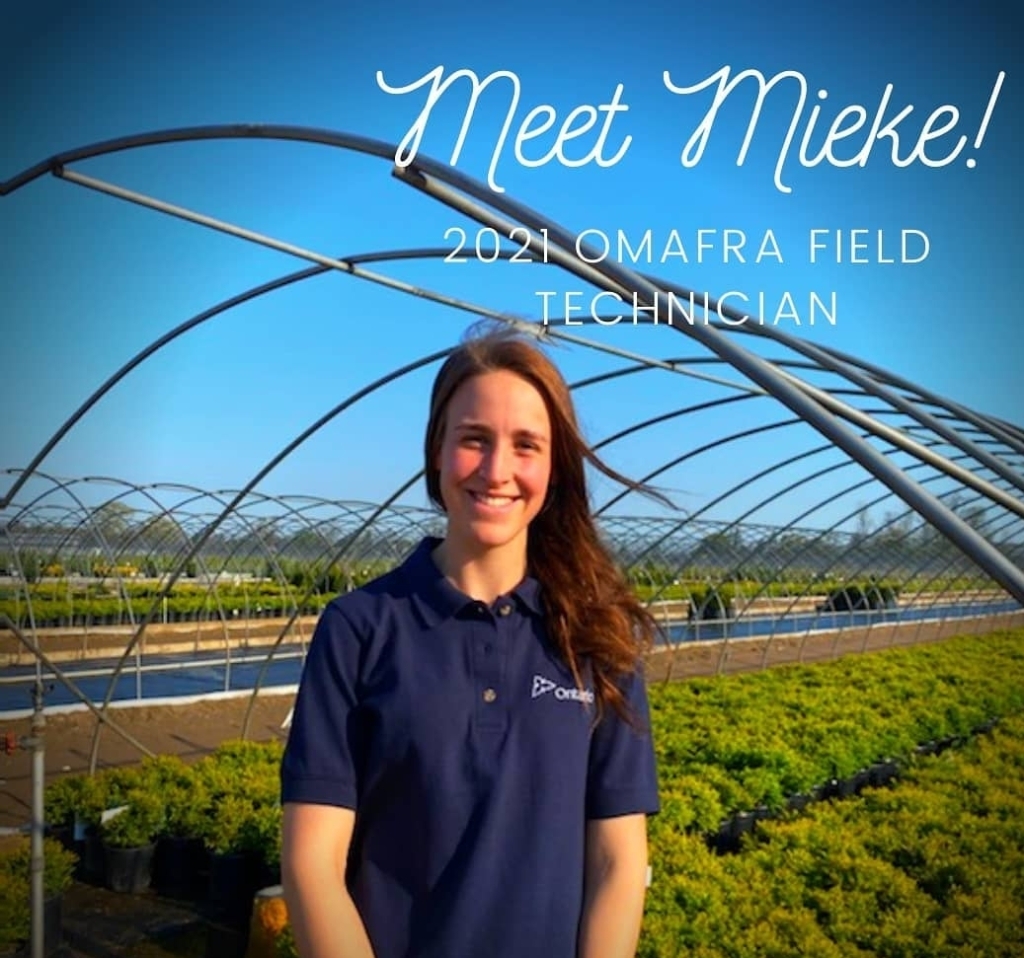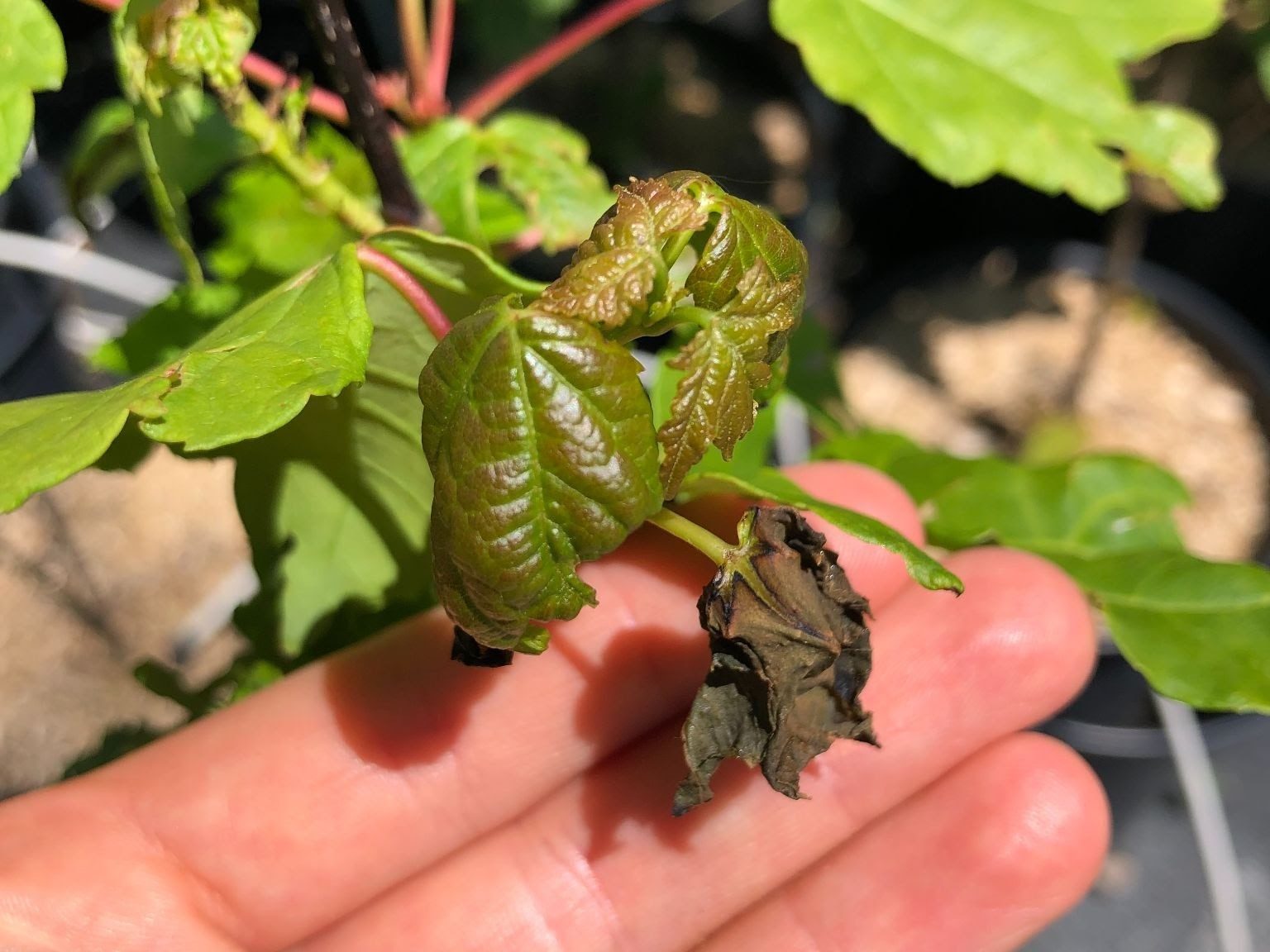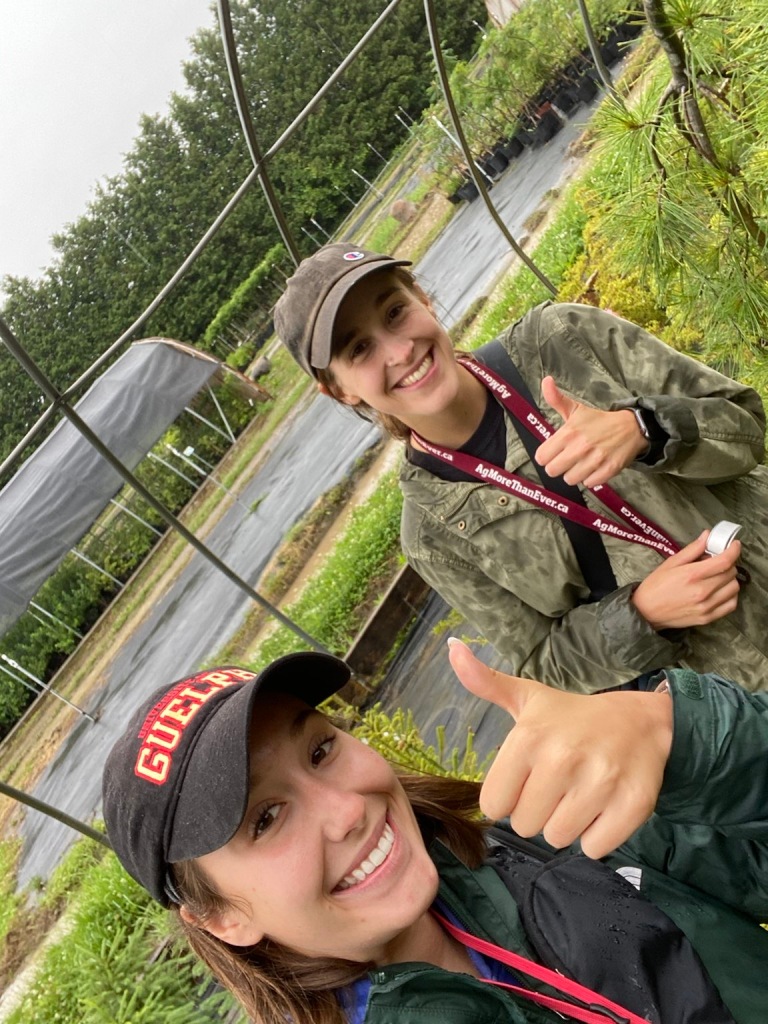
I am Mieke Boecker, the 2021 OMAFRA Summer Field Technician. I worked closely with Jen Llewellyn, OMAFRA Nursery and Landscape Specialist on several projects and this article outlines some of the highlights of my summer contract with OMAFRA.
I am a fourth year Environmental Management student at the University of Guelph. One of my main interests is urban greening and climate change adaptation, so I found this summer job to be very fitting.
As a field technician, I gained deeper insights into how the plants, that will one day line our city streets, highways, and parks, are produced. I think that increasing the amount of greenspaces in cities is one of the best ways to help mitigate the increase in summer temperatures that will result from climate change in the coming decades. It’s reassuring to know that Ontario’s nursery crop production is very extensive, meaning that we will have many more trees to go around for a long time!
I spent a lot of time assisting with the OMAFRA-Landscape Ontario Nursery Scout Program and had the pleasure of working with Lexie Cupoli, the Nursery Scout and recent grad of the University of Guelph.



What a riot this summer has been! I think that one of the greatest takeaways from our summer jobs is the people we got to meet along the way. Each nursery that we went to has its own unique story, shaped by the lay of the land and the personal history of the business. Owners and employees were always eager to help, answering any questions we had, in order to improve the quality of the scouting reports. So, to you we say thank you for welcoming us into your world during the 2021 growing season. We’ve had a blast!
Throughout the course of the summer we scouted through all kinds of growing setups, from polyhouses to greenhouses to field-grown trees. This huge variety of plants and environments meant that we came across A LOT of different pests, diseases, and other mystery problems! As a recap, I’m going to go over four of the most memorable aspects from our 2021 scouting season. Hopefully these highlights will also provide you with some cool insights on plant health and pest management! And without further ado, here they are:
Secrets of the soil
I remember the day very well, there was a consistent, heavy rain as we trudged through rich, clayey fields. The soil stuck to our boots like glue, making them ten times heavier (au naturel ankle weights so to say). All of the rows of shrubs we were inspecting looked just fine – leaves were the right colour, there was no sign of disease, and stems and branches looked strong. And then we came across some river birch (Betula nigra), which did not look fine at all. In rows that were about 500 trees long, there were sections of 10-20 trees exhibiting extreme chlorosis as well as some that had died entirely. Our first thought was that this was a disease – perhaps these issues were caused by a harmful fungus? Our other suspicion was that it wasn’t a disease and instead there was a root-munching grub making its way through the field.

From our training with Jen, we knew that roots can tell you a lot about the health of a plant, so we went to work digging up several birch trees at varying stages of decline. The roots didn’t really support our hypotheses – there were no discoloured lesions on the roots that could have pointed to a fungal infection, nor were there any signs of chewing by grubs.
So what could it be? We took another look at the field and noticed that it wasn’t completely flat. It had a bit of a dip in it . . and the birch trees planted in the dip were the ones experiencing the most severe symptoms. Suddenly it dawned on us: the depression in the landscape must result in those birches experiencing a higher, prolonged soil water content. River birch do thrive in moist soils, but roots also need air.
Jen encouraged us to explore this idea further by doing a hand soil texture test with soil from the root zone. First we tried to make a ball with the soil and also squeezed it between our thumb and index finger to make a soil ribbon. The longer the ribbon, the greater the clay content. Then we put a small amount of soil in our palms and added water to make a soupy mix, and used the index finger on our other hand to feel the texture of the predominant particles, in this case the clay and sand. And sure enough, we were able to determine differences in the clay content and those differences corresponded with tree health. The birch trees that were growing in areas with a higher clay content often looked less healthy. I found it fascinating how much of a difference a slight change in soil texture can have on the well-being of a particular crop. Equally fascinating is how easy it is to carry out a quick soil texture analysis.






The Year the Gypsy Moth Took Over
If there is something that united us this year, other than the pandemic, it was our collective, human astonishment at the abundance of the gypsy moth (Lymantria dispar) in urban as well as rural landscapes. It was everywhere. The Plant Health course I took this past winter taught me that a single larva can consume over 1 square meter of foliage in just one day – a ridiculous amount. And on top of that, they also don’t discriminate when it comes to hosts. Despite having a clear favourite, oak, they can also be found devouring maples, lindens, poplars, willows, beeches, and even blue spruce.
Another interesting fact that I learned from Jen is that most healthy deciduous trees can tolerate one season of being defoliated by gypsy moth. The next spring, most are able to bounce back and hopefully don’t experience a second defoliation. However, a second consecutive year of defoliation can be lethal to oak, especially red oak. Conifers, on the other hand, cannot even handle a single complete defoliation. Unlike the leaves of deciduous trees, it is far more difficult for them to recover from extensive gypsy moth feeding and many spruce trees will need to be removed due to mortality over the next few years.



Earlier in the season, Jen conducted an experiment in which she assessed whether treating gypsy moth egg masses with horticultural oil would result in reduced hatching rates. I was the lucky individual who got to do all of the egg counting. Despite the tediousness of the tiny little eggs, it was a really interesting task and it’s always fun to look at things through a microscope! Separating the eggs from the fluffy hairs of the egg mass was another story . . . lots of cooking oil to get them off. But it was all worth it because in the end we had concrete numbers of eggs per egg mass to work with. Overall, the experiment found that applying dormant horticultural oil reduced the number of hatched larva by around half, which is a promising discovery. More research will need to be done, but this result could help to improve the management of this invasive species.
On the Hunt for a Smooth Green Criminal



Potato leafhoppers migrate from the south into Ontario in late May. They will land, mate and lay eggs on newly emerging foliage of deciduous trees, in addition to forage crops such as alfalfa. We had some chuckles over the funky dance moves of the wingless nymphs, moving side to side all day long.



We learned that the most effective way to evaluate their abundance is through sweep-netting, as Lexie is demonstrating above. There are many ways to sample insects by sweep-net. Personally, I like to swing it in a right-left-right-left-right fashion while walking in between two rows of trees. Others like to do five sweeps on the right side and then do five sweeps on the left side – whatever floats your boat. By counting the number of potato leafhopper adults and nymphs that land in your net per sweep, you can quantify the average number of them per a given number of sweeps. A low abundance is 0-3 per net whereas we’ve had higher abundances ranging from 10-15 hoppers per sweep.

Although they are known to hang out on maples, we spotted them on honeylocust, river birch, and even willow too. A telltale sign of their presence is a symptom called “hopper burn”. Hopper burn results from the potato leafhopper’s feeding on a plant’s new growth. At first the leaves will look droopy and wilted and eventually the dead tissue will take on a scorched, black appearance, much like kale chips that have been left in the oven for too long (very crispy).
Box Tree Moth Has Entered the Ring
This summer we were able to experience firsthand the urgency of invasive species management efforts. Box tree moth was first discovered in Etobicoke in 2018 and has since spread throughout the GTA and beyond. Efforts were made to contain its dispersal in southern Ontario and prevent it from spreading into the States. Unfortunately, as with all invasive species, there is usually at least one that gets away. After it was found at an Ontario nursery this spring, a flash scouting mob was organized and we combed through thousands of potted boxwoods in an attempt to find any remaining larva. This was done to reduce the potential of more larva being shipped out to other places. That day is also when I got to meet Abbie Wiesner, a Master’s student at the University of Guelph, for the first time. As some of you may know, she was Jen’s nursery scout in 2019.

As a Master’s student, Abbie’s work revolves around the box tree moth’s biology and management and also its feeding behaviour. Holly and Euonymus have been labelled as potential alternative hosts of box tree moth, which has become a significant trade barrier. I helped to conduct a no-choice feeding trial at the UofG that will be used to determine their suitability to support the larval stage of this pest. This is an important area of research as both of these plant genera also had exportation bans placed on them. If Abbie’s research reveals that box tree moths cannot complete their life cycle on these plants, then they may be allowed back on the international market. And the sooner this can be confirmed, the better.



Although there are no boxwood species native to Canada, boxwood is still an important pest to keep track of, due to the popularity of boxwood in the landscape industry and to the greater public. Another method that is being used to track the dispersal of the box tree moth in Ontario are pheromone traps. Landscape Ontario’s Jeanine West and OMAFRA’s Jen Llewellyn and their colleagues have been orchestrating the distribution and monitoring of these traps. These are located in a wide geographical band that wraps around the GTA and hugs the border with the US, providing extensive monitoring of the species. They are green plastic canisters with an opening at the top that allows the moths to enter, enticed by the scent of a sex pheromone lure. If you are ever near one of these, try not to touch the lure directly, as its attractive smell may carry over to you. Being popular with the bugs may sound tempting to some, but for most of us it’s probably something we want to avoid. Just ask Lexie, a proud bug net owner.
This brings me to the end of this blog post. I hope you’ve enjoyed reading about our experiences this summer and maybe you know someone who might be a good fit for the next season! Take care (of yourself and your plants!) 🙂



